Mary Andrews Clark Residence of the YWCA
1912 – Arthur B. Benton
306 Loma Drive – map
Declared: 7/7/76
Two decades before William Andrews Clark, Jr, bequeathed HCM No. 28, the 1925 Clark Library, to UCLA in memory of his dad, Clark Sr built this YWCA residence hall as a memorial to his mother, Mary.
Actually, the idea of building the Mary Andrews Clark Memorial Home, an “Institution of Comfort and Uplift,” can be credited to Clark’s sister, Mrs T.F. Miller, chairwoman of a special committee of the YWCA in Los Angeles, then on Hill Street downtown.
Clark, a former Montana senator, donated the cost of the project, about $200,000, chicken-feed, if you consider the stinking-rich Copper King was then living in his $10,000,000 mansion on Fifth Avenue in Manhattan.
Architect Arthur Burnett Benton (we ran into him at HCM No. 63), was already responsible for a few of the city’s YMCA and YWCA quarters when he created for Clark a very, very large building in the French Chateauesque style at the southeast corner of 3rd Street and Loma Drive. The memorial was “designed to afford a comfortable home and a protecting influence for working girls.”
From the Dept of City Planning website.
Did I mention it’s large? 200 x 132 feet including an open court of 100 x 112 feet. In fact, it’s so huge, it’s tough to get a shot of the whole thing (a little help, Martin Schall?). And don’t bother trying to get a good shot of the courtyard. I’m quite pro-tree, but it sure would be nice to see it opened up a bit.
In the early summer of 1912, while the building’s roof was being put up, the Los Angeles Times reported on what we’d find inside the building back then. The first floor originally held the lobby, administration offices, a large reception hall, two private parlors, a library, a lecture room to seat 300, a dining room for 200, and a gymnasium. The rest of the building held dormitories for about 200 girls, sleeping porches, sewing and workrooms, classrooms, a laundry, and a complete hospital suite.
After sustaining heavy damage in the Whittier Narrows earthquake, the building closed in 1987. Three years later, the YWCA sold it for $3 million to a non-profit developer, the L.A. Community Design Center. The group hired Killefer Flammang Architects to perform a seismic upgrade and renovation on the 76,600 square-foot landmark, turning the structure into an SRO with more than 150 rooms (had they not gotten to work when they did, the monument, in all likelihood, would’ve been lost in the Northridge earthquake). The Mary Andrews Clark Residence was rededicated in 1993 and re-opened in October 1994, with each floor having “a communal kitchen and lounge, and shower enclosures have been built into the hallways because most of the rooms have only half-baths.” Total rehabilitation costs ran to $16 million.
Killefer Flammang won a bunch of awards for their work, including a Merit Award from the AIA California Council and the L.A Conservancy’s Preservation Award. It was also in 1995 when the building was added to the National Register of Historic Places.
Thanks to a security guard, I got a quick look inside, but missed out seeing many of the rich details heralded back in 1912. It still looked to be in good shape.
Oh, and check out this list of just some of the movies (including The Wedding Planner and The Ring 2) and TV shows (ER and Charmed, for instance) filmed at the Mary Andrews Clark.
Sources:
“Working Girls’ Home Now Taking Shape.” The Los Angeles Times; Aug 11, 1911, p II1
“Memorial Home Takes Shape.” The Los Angeles Times; Jun 30, 1912, p. V1
Berestein, Leslie “Old YWCA Home is Reincarnated” The Los Angeles Times; Feb 5 1995, p. 8
Up next: Ralph J. Bunche Home



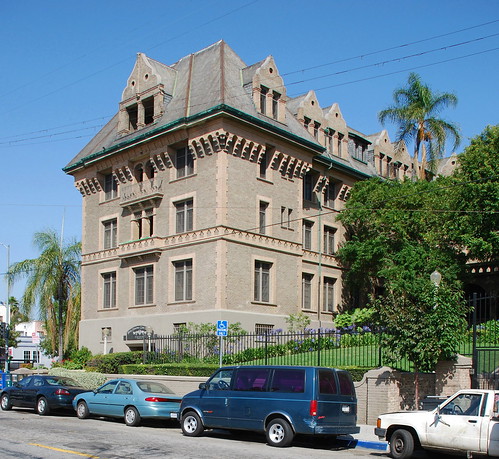
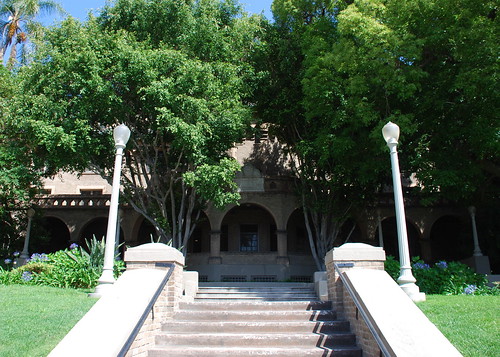

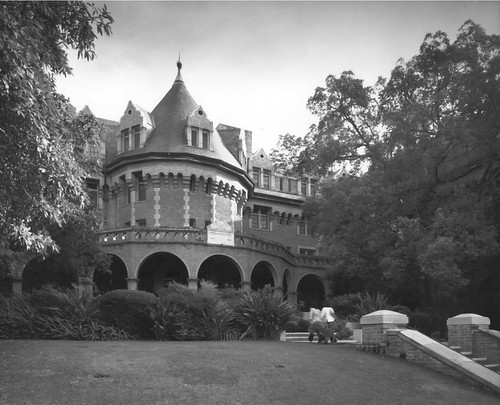
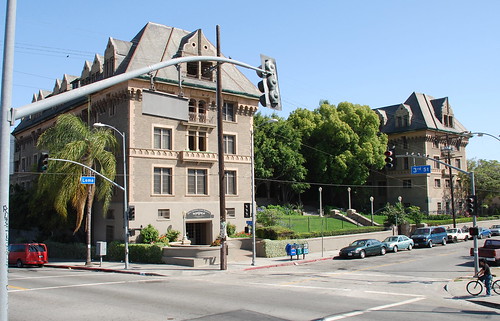
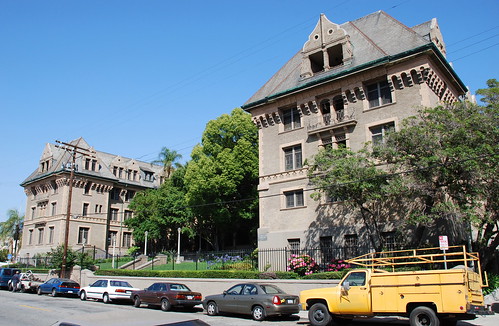

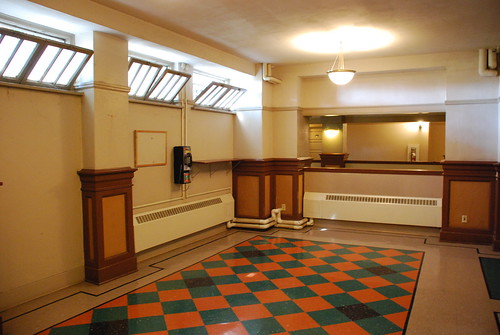
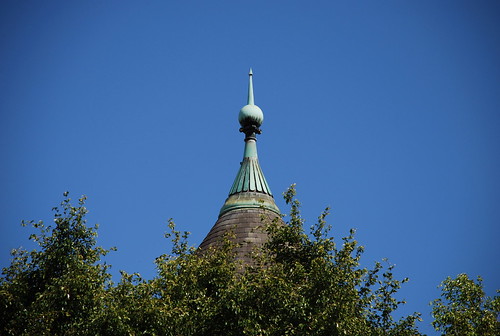

23 comments:
Very interesting. Probably deserves a notation by past occupants of how the situation improved their lives.
It's a wonderful building with exceptional views of downtown from the back balconies. Shame that when new management came in recently, the surviving stained glass details in the library vanished. This is according to a resident who tried to show them to me and was confused to find them gone. They might have gone away with one of the many film crews that use the space, but the timing is suspicious.
...i will be happy to support you with my ultrawide lens next week!
Thanks, Martin! Let me know how you make out.
I was one of those residents back in 1960-62, and when I met another girl from Canada, we moved out to an apartment. Then we heard about dances being held in the auditorium and went back one Saturday night. My future husband was there as he had also heard about the dances, and he loved to dance! He took me home, we dated for three years and then married. I was so pleased to see a website on the Clark Residence and have copied off many pictures of the outside and I can pinpoint the area where I first met my husband to show to our daughter. I have taken many friends to show them where I used to live and was able to get inside only one time and then only on the first floor to show them what used to be the living room, dining room and auditorium. I am still friends with the first girl I shared a room with and also the girl I shared an apartment with. The Clark Residence (YWCA) was a very safe place for someone new to Los Angeles, and I still have the pamphlet that was given to me to introduce me to the residence and what all they had to offer. I love to watch the movie "Twins" and I can see what used to be the front entrance and the living room. The phone number back then was
HU 3-5780.
What a great comment! Thanks so much anonymous. If you ever get around to scanning that pamphlet, that sure would be great to see. In any event, thanks, again, for the stories.
It's hard to grasp the scale of the building in the photos. I've had good luck using maps.live.com to gain a good perspective in these cases. Here's a link to the Clark Residence:
http://tinyurl.com/dkkdp7
I came down to Los Angeles in 1965 to go to Chouinard Art School (today called California Institute of the Arts) and lived in the Clark Residence for two years. I was telling my husband about it today and decided to see if there were any pics online I could show him. These are terrific!
This was a great place to live for a young girl away from home for the first time. My parents paid the monthly rent, which included everything. I didn't have to worry about food, friends, safety, or cleaning house. It was a good "base of operations" so to speak. You could have a room of your own, or could pay a little more per month and share a room. I lived by myself in a room with my own half-bath (separate small room with toilet and sink). It was a pleasant, comfortable room with a closet, twin bed, and dresser that had a mirror. I taped up posters to give it a homey feel. The weekly housekeeping service was really nice. There were multiple showers in a room down the hall. We weren't supposed to wash our hair in the showers, but were supposed to go down to the basement where there were big laundry sinks that wouldn't get stopped up...but no one did that; we just washed our hair in the shower.
The two "parlor" rooms on the first floor were small, pretty rooms, with a sofa, comfortable chair, and lamp. Each had a door that was half-glass with a dainty lace curtain. This was where the young ladies could entertain their gentleman friend. If evening came and you didn't turn on the light in the room, one of the little old ladies who kept an eye on things would quietly come into your room, turn on your light to make sure nothing frisky would happen, and leave. The dining room was large with many tables that would seat 6-8 girls, and the meal was served buffet style. The food was very good, and we ate with sterling silverware. Also on the first floor was a separate kitchen for those who wanted to cook and eat meals separately, or at times other than breakfast and dinner. I determined to teach myself how to cook an egg "over easy" one day and, armed with a dozen eggs, proceeded to destroy all of them in the attempt. That was the only time I used the kitchen.
The basement was enormous, with a high ceiling; I don't think it ran the width of the building, but you get the idea. Even with the lights on it was shadowy and a little spooky - probably why it wasn't used much. It had several large laundry sinks where you could wash clothes. At one end of the room, stacked next to each other, were pull-out dryers for your clothes. They worked similar to what you sometimes see in medical offices, where you can grab a handle and pull out a stack of shelves with medical records. The dryers had long medal rods that you could hang your clothes on, push back in, and hot air would circulate to dry your clothes. In the basement they also had treadle sewing machines for use...the first and only time I used one of those.
I made a lot of friends there, and met a diverse group of women when we dined. I remember a group of girls who were in Los Angeles to attend finishing school, a girl from the middle east, someone who wanted to be a flight attendant (stewardess, we called them back then), and one girl whose dream was to become a nun and who volunteered every weekend at a convent. I became friends with a resident who was from England, and we subsequently moved to an apartment down the street as roommates.
Thank you for sharing these photos; I have none of my own, and these brought back some wonderful memories.
Thank you for the wonderful comment, anonymous. It's very much appreciated.
I lived at Mary Clark in 1981. It was wonderful! I, too, am still friends with girls/women I met there. What a place it was...! Great memories. Thank you for this site.
I lived at the Clark House in 1968. All of the "FBI girls" were sent either to there or the Sal. Army Booth house when they first arrived. I had never been on my own and appreciated the old-fashioned supervision. I had a lovely room with a balcony. I met a lot of friends and it was my first experience living day in and day out with other cultures.So many firsts I would not have had on my own. I met a very tall girl who belonged to a "Tall" club. I got to know a South African girl of mixed race who told me she couldn't even walk on the sidewalks with apartheid. One girl decorated her entire room in shades of yellows - we would all stop by to see her latest acquisitions from Ports of Call in San Pedro. I'd never taken time for breakfast in my life but since everyone was down there and the food was already cooked... and dinners were almost as good as home. Even when I got a small apartment, I shared with one of the federal girls I'd met at the Clark House. I'm sorry to hear it was damaged in a quake. I would feel very secure to know my granddaughter, who will leave home in 8 yeas, would have someplace like that to get used to the big city. Sandra Wheeler, now Dayton, OH.
Thanks so much for the reminiscences, Dr Wheeler.
We have a family member who, according to the 1930 census, was a lodger at the Mary Andrews Clark Memorial Home. We can find no further record of him. Do you know if any records from that time still exist? His name was Henry Lidgate.
Diana
I had passed this beautiful building a dozen times, always struck by it. I was driving by with a friend in the car, telling her about this beautiful structure and how curious I was to know more about it, she read the sign "Mary Andrews Clark Residence" and texted it to me so I wouldn't forget to look into it further. This is how I found your site! Thank you for the wonderful pictures and information, thank you to the ladies that shared their memories of living there - I am completely charmed by the stories and only wish it was still such a sanctuary. But thank goodness it seems to be well preserved. I was also pleased to learn that William Andrews Clark built it for his mother. His son, philanthropist William A. Clark Jr. happens to be buried in the cemetery I work for in one of the most impressive private mausoleums in L.A.! So I am quite familiar with him, but did not know of this lovely building for his grandmother. Thank you for your site!
Thanks very much for the nice comment, Chanell.
I lived at Clark's for about 6 months from July 1983 to about January 1984 when I was in Job Corps. It was considered to be one of the "honor dorms." I really enjoyed living there. I am glad that they have fixed the place up and have reopened it. I now live on Loma Way in another city.
I wonder how much it costs to live there and if anyone not living there (like me) can take a look around? Do you think that can be worked out Floyd?
My mother lived there in 1942. A cousin helped her move and brought along a friend to help. His last name was Clark. They dated for 3 months then married. She went from one Clark home to another! She loved it there. Secret: my dad worked nights and he would throw rocks at mom's window and she would come out and sit with him and talk for awhile before going back in without getting caught! They were married for 68 years!
I have a distant relative who, according to the 1930 census, lived at the residence. I am intrigued by the building and it's story but getting more information has been a bit challenging as I live in Canada. Are there books about the building, pictures of the inside during the early years and/or information about it's occupants. I'd like to find out when she arrived and when she left.
Thank you!
I lived in the Clark Residence in the summer of 1965. Good memories of meeting girls from all over the world. I had a balcony room -- the balcony was shared by everyone on back side of the building. We could see the fires of the Watts Riot from the balcony in the distance. Fresh flowers on the tables at meal times. We could sunbath on the roof! I shared the room with a sweet woman from England. Good memories. So nice to see these photos.
I lived in the Clark Residence in the summer of 1965. I enjoyed meeting girls from all over the world. My room in the back of the building had a shared balcony. We could see the fires of the Watts Riot from the balcony off in the distance. There were always fresh flowers on our dining tables. I shared a room with a sweet woman from England. We could sunbath on the roof! Good memories! I enjoyed seeing these photos so much!
I moved into the Clark Residence in 1954 and shared a room with a girlfriend. Then it was known as a residence for single working girls. Everything was included in my very low rental fee. The cost was based on ability to pay. The job I had in an insurance office downtown paid $150 per month. You could invite a guest for dinner every now and then. Men were not allowed above the first floor and were restricted to the parlors. Many of the girls who lived there would sit in their boyfriend's car outside for heavy necking sessions. I moved out in spring of 1955 when my soldier fiancé returned from Korea and we were married that June. We were together for 40 years until 'death did us part.' I have very fond memories of the place. Today I'm a published romance author.
Post a Comment